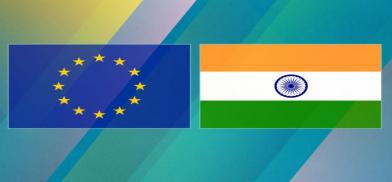India and the European Union: Growing partners in technology
Both DPI and AI are data-driven and integral to future human development. In 2024, India and the EU are looking to formulate a unified approach towards these two cutting-edge aspects of technology.

In the middle of the COVID-19 pandemic in 2021, I arrived in Hamburg, Germany, to pursue my doctoral studies. My family and I were confined to our apartment. Life under lockdown in Hamburg was almost similar to life back in my native city in Pune, India, barring one exception. In Germany, cash was the king. After three years, things have improved only marginally. On the other hand, India has taken the lead in building digital public infrastructure (DPI). DPI is assisting India to revamp the country’s image as a technology importer. And now the Narendra Modi-led Indian government is attempting to leverage DPI in the arena of foreign policy. European States are keen to understand more about the DPI story and engage with India on the same.
At the same time, the Indian government is looking at Europe as a destination to gain knowledge about other sectors of technology, especially Europe’s green technologies. Europe’s helping hand may facilitate India’s climate mitigation strategies. Post-COVID-19, the changed realities are reflected in the formation of India-EU Trade and Technology Council (TTC) in 2022. The last meeting of the council was held virtually in November 2023. The rationale for formulating TTC is to work on a strategic partnership. The focus is on both trade and technology. However, in this article, I would like to focus on the technology aspect of the partnership. India and Europe, being democracies, have also realized the need to set democratic standards concerning technology. COVID-19 was a warning call and pushed both sides to engage in supply chain resilience.
TTC has formulated three wings. The first wing deals with emerging strategic technology. The wing looks after 6G, AI (Artificial Intelligence), and semiconductors. The second wing tried to build mutual understanding about green technologies. So, green hydrogen is an integral part of the wing. Research and innovation concerning climate are included under this wing. The third and last wing pertains to trade investment and supply chain resilience. TTC runs parallel to Free Trade Agreement discussions. Despite the political intervention, those discussions are facing hurdles.
Understanding on semiconductors
India and the EU have already signed a MoU on semiconductors. It helps India to create an ecosystem and assists the EU in diversifying supply chains regarding semiconductors. The bilateral understanding on semiconductors has implicit reference to China. Thus, independent of FTA negotiations, TTC has proved its worth. However, it does not substitute FTA. Instead, TTC hints that India and the EU can come together for strategic purposes and provide a broader framework to work for resolving FTA issues.
Therefore, from the Indian perspective, green financing and technology transfer are critical issues, and TTC is a better forum for building mutual understanding about the contentious issue. Another crucial issue is shortage of skilled labor in European States. Indian young professionals are a worthy alternative. In this context, TTC may facilitate building uniform migration-related standards for these professionals.
In May 2023, TTC deliberated on DPI and acknowledged its role in achieving SDGs for the developing world. During the G20 presidency, India announced the creation of a virtual depository of DPIs. The virtual depository is expected to be shared with G20 members and other interested States. India is providing access to the depository equitably. India has also proposed One Future Alliance (OFA) to augment the capability, technological assistance, and funding to States with limited resources in the Global South. The Modi government has indicated that DPI is for the global common. At present, 16 countries have added close to 50 DPIs to the repository. European countries have also shared their own DPI in the repository. France has taken a keen interest in the India-developed Unified Payment Interface (UPI) and other European countries have also opened their ‘gateways’ for Indian DPI development. India and the EU are also partnering to build DPI in third countries.
Recognition of DPI framework
During the G20 meetings, DPI offered India an opening to introduce its lexicon in the global geo-strategic domain. The digital economy ministers adopted the DPI framework. Though the framework is non binding, the G20 member states acknowledged the existence of DPI, and its vocabulary has an Indian imprint. The EU is best suited to understand the relevance of such norm-building. The first wing of TTC relates to AI and digital governance. Both DPI and AI are data-driven and integral to future human development. In 2024, India and the EU are looking to formulate a unified approach towards these two cutting-edge aspects of technology.
Data privacy is a key concern for India and the EU. The EU particularly is sensitive to data privacy concerns. Here, the Indian track record is patchy. Recently, the Indian parliament passed a bill on data privacy and took a step toward building a sound legal framework. The EU has an established framework on data privacy. However, India needs to create more awareness about data privacy. In this regard, India can learn from the EU. In the deployment of the legal frame, TTC may provide broad guidelines. Here, the role of OFA becomes relevant. On the lines of the International Solar Alliance, Coalition for Disaster Resilient Infrastructure, India has augmented OFA to discuss digital-related concerns. The OFA proposes to bring together all stakeholders, government, private sector, academia, and civil society to develop mechanisms for DPI.
Pushing new thinking
India is keen to shoulder new global responsibilities. Furthermore, India as a pole is enthusiastic about inculcating democratic values at a global governance level. This perspective is integral to India and the EU’s decision to assist countries from the Global South on the technology front. New Delhi is pushing traditional "Bhartiya thinking" about facilitating change in the third country through strengthening capacities rather than exporting ideas. Therefore, New Delhi insists on partnership and consent of interested countries. Moreover, it suggests that India distances itself from binary considerations of ‘with me or against me’. EU is also learning more about this "Bharat Way"!
At the same time, India’s leadership recognizes the unpredictability of global affairs and understands the need to engage with European nations. The reason seems to be historical. In the last two centuries, the West and especially Europe have been integral to each and every growth story. India knows that the existing world order works on the institutions and practices developed by the West in general and Europe in particular. Therefore, as India's External Affairs Minister S Jaishankar says, India is non-West but not anti-West and is happy to engage actively with the West. The present harmony in the relationship between two democratic societies is inspiring hope. And the India-EU partnership centred on technology and trade is emerging as a factor of global stability.
(The author is a KAS scholarship holder and pursues doctoral research at the University of Duisburg-Essen, Germany. Views are personal. He can be reached at : aubhavthankar@gmail.com; X: @aniketbhav)














Post a Comment